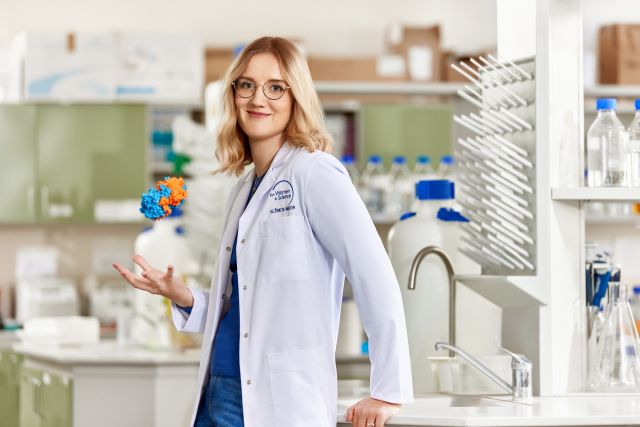Principal Investigator
:
mgr Elżbieta Wątor
Jagiellonian University
Panel: NZ1
Funding scheme
: PRELUDIUM 18
announced on
16 września 2019 r.
Responsible for all important processes in living cells, proteins are made up of amino acids linked together by peptide bonds. A standard list of these building blocks consists of 20 amino acids encoded by DNA sequences (codons), whose different arrangements allow for a practically unlimited number of sequence combinations and, as a corollary, of spatial structures responsible for chemical reactions in living cells. However, there are also proteins whose function is “encoded” by more than the standard set of amino acids. One of the ways in which the available set can be expanded is known as post-translational modification, whereby specific chemical groups are added to the polypeptide chain. The post-translational modification of amino acids could be likened to an addition of diacritics that change some letters into others (such as “ą”, “ć”, “ł”, or “ń” in the Polish alphabet). Modifications of this kind can affect practically every aspect of protein function, including its structure, stability, charge, cellular location and activity. Some are very common and observed for many proteins; for instance, phosphorylation, or the attachment of a phosphate group to serine, threonine or tyrosine residues, occurs in up to 30% of all animal proteins, and enzymes involved in phosphorylation may modify many different proteins. There are also rare modifications that occur in only one protein, or even a single amino acid at a specific position in the protein sequence; a case in point is hypusination, or the post-translational modification of lysine residues into a unique amino acid (hypusine), thus far only described for one protein: the eukaryotic translation factor 5A (eIF5A). The process is catalysed by two enzymes: deoxyhypusine synthase (DHS) and deoxyhypusine hydroxylase (DOHH). Thanks to its long hypusine side chain, hypusinated eIF5A can bind to the ribosome to regulate protein biosynthesis, and in particular, to support the ribosome in the production of difficult protein sequences, e.g. rigid sequences containing multiple proline residues in a row.
 mgr Elżbieta Wątor fot. Program LOréal-UNESCO Dla Kobiet i Nauki
Hypusination is a very important process in living cells, with well-studied associations with, e.g. oncogenesis, rare genetic neurodevelopmental disorders and diabetes. Within the framework of our projects, Molecular basis of hypusination (2019/33/B/NZ1/01839, PI: Dr hab. Przemysław Grudnik) and Targeted inhibition of the hypusination pathway (2022/47/B/NZ7/01667, PI: Dr hab. Przemysław Grudnik), we have used the methods of structural biology and biochemistry to study the process as it occurs in human cells. Hypusination, however, is also vital for the cells of different parasites, such as Plasmodium vivax, Trypanosoma brucei, Entameba histolytica or Trichomonas vaginalis. The selective inhibition of proteins involved in the hypusination process in these parasite cells could find important applications in new therapeutic strategies.
mgr Elżbieta Wątor fot. Program LOréal-UNESCO Dla Kobiet i Nauki
Hypusination is a very important process in living cells, with well-studied associations with, e.g. oncogenesis, rare genetic neurodevelopmental disorders and diabetes. Within the framework of our projects, Molecular basis of hypusination (2019/33/B/NZ1/01839, PI: Dr hab. Przemysław Grudnik) and Targeted inhibition of the hypusination pathway (2022/47/B/NZ7/01667, PI: Dr hab. Przemysław Grudnik), we have used the methods of structural biology and biochemistry to study the process as it occurs in human cells. Hypusination, however, is also vital for the cells of different parasites, such as Plasmodium vivax, Trypanosoma brucei, Entameba histolytica or Trichomonas vaginalis. The selective inhibition of proteins involved in the hypusination process in these parasite cells could find important applications in new therapeutic strategies.
In my PRELUDIUM project, I turned my attention to the DHS protein of Trichomonas vaginalis, the parasite that causes trichomoniasis in the human urinary and reproductive system. Earlier reports suggested that the entire hypusination process in Trichomonas vaginalis is catalysed by a single bifunctional enzyme. Since it is rather uncommon for one protein to catalyse two completely different chemical reactions, we decided to harness the methods of structural biology and biochemistry to describe the unique process of hypusination in the cells of this parasite. Thanks to structural biology techniques such as macromolecular crystallography or cryogenic electron microscopy, we succeeded in deciphering the structure of DHS and eIF5A proteins involved in hypusination, as well as that of the DHS-eIF5A protein complex. Complementary biochemical experiments and structural data analysis suggest that hypusination in T. vaginalis cells is indeed completed in one stage, but limited to the synthesis of deoxyhypusine. The high-resolution crystal structures of proteins sourced from Trichomonas vaginalis that we obtained are also being used to identify orthologue differences between species, which opens up new avenues for designing species-specific inhibitors.
Project title: The protein with two faces – characterisation of a dual-activity deoxyhupusine synthase from Trichomonas vaginalis
mgr Elżbieta Wątor
PhD student at the Małopolska Centre of Biotechnology at the Jagiellonian University. Winner of the L’Oreal For Women in Science 2023 programme. She has worked in SONATA and OPUS projects and served as the PI under a PRELUDIUM project since 2020. She has acquired expertise in structural biology during several international research fellowships, e.g. in the Bessy synchrotron in Berlin, CFEL in Hamburg, Philipps-Universität in Marburg and Max Delbrück Center in Berlin. She is the winner of DAAD and NAWA Bekker scholarships and an author of 8 publications, including a Nature Communications paper describing the mechanism of the first stage of hypusination.


